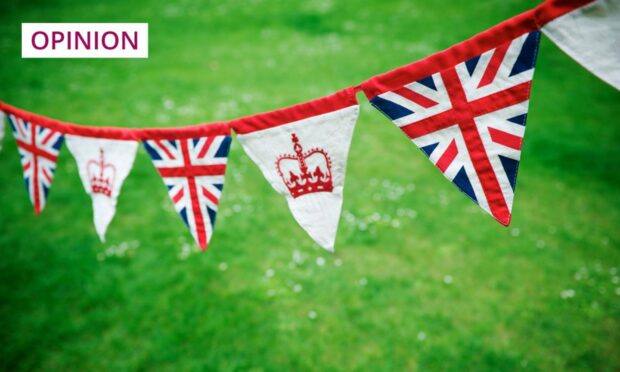It starts with a gentle chime on my phone: an update from SeeSaw, the app my children’s school and nursery uses to give us an idea of what they’re doing during the day.
It is my favourite notification noise; I get a wee Pavlovian rush, anticipating pictures of my six-year-old, polo shirt untucked from his school trousers, grinning happily through his glasses as he holds up a sentence he’s written, or a little video of my three-year-old and his pals building castles with wooden blocks. Tiny flushes of love to get me through the working day until I can hug them at the school gates.
This time, though, the chime ushered in a picture of six primary ones, including my son, heads bent over a table, red and blue pens in hand, colouring in pictures of the Union Jack.
A demonstration example of the flag itself sits in the middle of the table. The caption reads: “Today we have been learning about the Queen’s Jubilee!”

I am not taking my feelings about this to the primary one parents’ WhatsApp chat. Any parent group chat where the common bond is a particular class rather than pre-existing friendship is a delicately balanced thing, particularly with people from small villages or close-knit communities.
I recognise and accept that not every parent will share my feelings about this particular picture, and I don’t feel the need to challenge their views or pick a fight with them on this, or anything. In this situation, the priority is the preservation of peace for the sakes of the children.
I am also not going to raise this with the school, I think. I love his school, and his teacher is doing a phenomenal job. There are layers and layers here – of community, of council expectation, of what teaching materials are available.
I’m just going to keep my head down, not rock any boats, and ride it out ’til normal, non-obsequious service resumes on Monday.
Instead, I exchange individual messages with two other women whose children are pictured; mostly just the vomit emoji or the angry, red, sweary face one. I screengrab, obscure the other kids’ faces and send to a couple of close pals. More vomit emojis, clenched teeth emojis, angry face emojis.
An unexpected conversation
The Union Jacks are displayed proudly in the classroom window at pick-up time.
My lovely, messy boy comes running out of the door, arms outstretched for a hug, bag and fringe and slightly-too-big trouser legs flapping about in the breeze. I swing him round in the middle of the playground and we walk together to the nursery building. He launches into it without even having to be prompted.
“Mummy, can we have a special celebration for Queen Elizabeth the Second’s birthday?” (This kid LOVES a celebration. Last Pancake Day, I came downstairs in the morning to find him hanging some special pancake bunting he’d made with safety scissors and sellotape at school.)
Despite having been thinking about the Union Jack picture for a few hours now, I haven’t considered properly what to say.
I’d sort of assumed that, being in generally monarchy-indifferent Scotland, this wouldn’t come up, even as I chose his lunch option for the Jubilee Day Picnic (pudding is strawberries, blueberries and cream, and it’s only just occurred to me why) and paid the sponsorship money for the Jubilee Scooter Ride (fundraising for Ukrainian children).
More difficult than explaining the birds and the bees
“Well. Mummy and Daddy aren’t really very comfortable with the idea of the Queen, baby.”
“Oh, don’t worry! I watched a video today so I’m very comfortable with her!”
“OK. So, Mummy and Daddy are what’s called republicans, which means that we don’t think anyone should be queen or king and have all that money and power over everyone else. And that flag that you were colouring in today – that makes some people uncomfortable, too.”
(This is harder than I’ve ever imagined the birds and bees chat being in my head, by the way.)
“It’s the flag of the United Kingdom.” He is so excited to tell me what he’s learned.
“Right. So, some people aren’t comfortable with that flag because it’s – well, it’s a symbol of times when the United Kingdom wasn’t so nice in the world.” We are now in the waiting room for the nursery, where a couple of little girls are wearing paper crowns that they have stuck sequins on.
“So, the United Kingdom used that flag when they went to war on other countries and took over those countries. Can you imagine if an army from a different country showed up here and said that they were in charge now, and we had to give them all our money and do what they said? And they did those things in the Queen’s name.”
Revealing all sides of the story
My son thinks for a second. His little brother is slowly making his way across the room to us, arms behind his back, in a series of rhythmic jumps.
“But, on the video there were children from other countries and they said thank you to Queen Elizabeth for 70 years of protecting them. So, maybe she made all of that stop.”
We all try to navigate this issue with tact, without judgement, without forcing our own opinions down our children’s throats
My heart sinks. This, I realise, is a longer conversation than we have time for, or than I have column space to recount to you. It takes us the rest of the day to gently unpick.
It takes in messages from some of the other parents, like “E shouted out: ‘My mum doesn’t like that flag!'” and “I managed to stop [husband] from angry posting about it on the app”. We’re checking in as we all try to navigate this issue with tact, without judgement, without forcing our own opinions down our children’s throats, whilst also making sure that they know there are always more sides to the story.
Scenes here in our household as our half Indian children are being given free books celebrating the queen’s lifetime and the commonwealth, asked to have picnics and wave flags while I am thinking of their great-grandfather who fought for freedom from the imperial rule. pic.twitter.com/eCy2stVJ7q
— Prof Pragya Agarwal (on hiatus) (@DrPragyaAgarwal) May 27, 2022
I look out for solidarity on social media in the evening, and discover that lots of Scottish schools seem to be ignoring the Jubilee completely, while Professor Pragya Agarwal, the Indian-English author, posts her discomfort that her six-year-olds have been given maps of the Commonwealth to colour in, replete with the disingenuous information that India “joined” in 1947. “As if it were a choice,” she writes.
But, it is an important conversation to be having and, hard as it is, much as I would have much rather waited until he’s older, I’m glad we’re having it.
The three-year-old, by the way, spent the day at nursery pretending to be a tadpole who had just developed legs. “I don’t like crowns,” he explained. “I prefer frogs.”
Kirstin Innes is the author of the novels Scabby Queen and Fishnet, and co-author of the recent non-fiction book Brickwork: A Biography of the Arches









Conversation